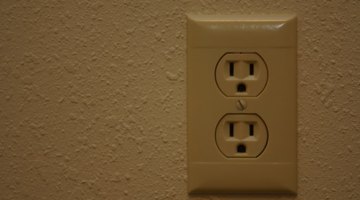Why Do Wall Outlets Get Warm?
People use so many gadgets around the home that run on electricity that it's easy to take that energy source for granted. When people flip a switch or plug something into a wall outlet, they expect that device to work. They do not give much thought to the electrical wiring in their home unless something goes wrong.

One of the things that can be problematic is a wall outlet that becomes warm to the touch.
Wall Outlets
Wall outlets usually have a pair of sockets. If the sockets have three holes -- two slits and a rounded hole -- the outlet is grounded, although older homes might have ungrounded outlets without the circular hole.
Outlet Warning
If any portion of an electrical wall is warm, or if the wall around it is, stop using the outlet and call an electrician to have it checked out. A warm outlet represents a fire hazard and can ignite a blaze. When a wall outlet becomes warm it means the total energy being used by the electrical gadgets plugged into that outlet exceed the capacity of the wiring to carry the load. In other words, the outlet is overloaded. For instance, when it comes to high-wattage electrical gadgets -- including appliances such as a microwave oven, toaster oven, convection oven, electric skillet or waffle iron -- plugging more than appliance into a single outlet usually results in overloading. Plugging extension cords into a wall outlet and then plugging many electrical items into the extension can also overload the outlet and cause it to become warm.
Outlet Basics
Electrical circuits are rated in amps. For example, if you had 100 amps of power entering your home breaker box, all the wiring could handle up to 240 volts of electricity. That translates to 24,000 watts of power. Electrical gadgets, from light bulbs to hair dryers to microwave ovens, are all rated according to how many watts of electricity they use. The outlets in your home are wired in groups, or circuits, into individual switches in the breaker boxes. Those breakers might handle 15 or 20 amps each. A 15-amp circuit can handle 3,600 watts of demand while a 20-amp circuit can handle 4,800 watts. If you plug electrical gadgets into outlets on a breaker that exceed that wattage, you overload the circuit and the wall outlets become warm.
Wiring Basics
Home wiring is either aluminum or copper. You can tell which one you have by removing the exterior plate covering the wall outlet and looking at the exposed ends of the electrical wires connected to the outlet. Throw the switch in the electrical power breaker box to the off position for that outlet to disconnect power before you remove the outlet cover. When you look inside the wall outlet if you see silver wires the wiring is aluminum while yellow, or copper-colored, wires are copper. Because aluminum wires tend to loosen when they heat up, look for any loose wires that might not be connected properly. But have an electrician take care of any problems.
The Drip Cap
- People use so many gadgets around the home that run on electricity that it's easy to take that energy source for granted.
- One of the things that can be problematic is a wall outlet that becomes warm to the touch.
- For instance, when it comes to high-wattage electrical gadgets -- including appliances such as a microwave oven, toaster oven, convection oven, electric skillet or waffle iron -- plugging more than appliance into a single outlet usually results in overloading.
- Electrical circuits are rated in amps.
- A 15-amp circuit can handle 3,600 watts of demand while a 20-amp circuit can handle 4,800 watts.
- If you plug electrical gadgets into outlets on a breaker that exceed that wattage, you overload the circuit and the wall outlets become warm.
References
Writer Bio
Jeanne Young began writing professionally in 2000. She was the government reporter for a daily newspaper in central Florida. Young has also covered general assignment and the business, health, science, environment and education beats for newspapers and a wire service, and written about money and politics. She holds a Bachelor of Arts in English from the University of South Florida.
Photo Credits
- Jupiterimages/Photos.com/Getty Images
- Jupiterimages/Photos.com/Getty Images
More Articles



